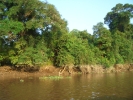 A report from the forest development department of the Ministry of Agriculture and Rural Development shows that Vietnam has 166,000 hectares of mangrove forests, 60 percent less than in the 1940s. Nhu Van Ky, a senior official of the department, said the coastal mangrove protective forests were being decimated because of the shrimp hatchery movement. More and more shrimp ponds have been built in the provinces of Tra Vinh, Bac Lieu and Ca Mau, while large areas of forests in the localities have been cleared.
A report from the forest development department of the Ministry of Agriculture and Rural Development shows that Vietnam has 166,000 hectares of mangrove forests, 60 percent less than in the 1940s. Nhu Van Ky, a senior official of the department, said the coastal mangrove protective forests were being decimated because of the shrimp hatchery movement. More and more shrimp ponds have been built in the provinces of Tra Vinh, Bac Lieu and Ca Mau, while large areas of forests in the localities have been cleared.
Ky said the forests have also been cut down to make room for agricultural production, embankments, industrial zones and seaports.
The state has been operating many afforestation programs in an effort to protect and develop forests. However, the programs have brought unsatisfactory results: only 50 percent of plants can grow into forests.
It is very difficult to plant forests in coastal areas, and the state’s investment rate to develop protective forests has been modest.
Tran Thanh Cao from the Northern Region Forestry Science Institute has warned that large areas of forests are being affected by climate change and rising sea water levels..
“The sea has been encroaching on the mainland. Meanwhile, more hydropower plants have been built on the upper course of the Mekong River Delta. Production workshops have been discharging waste water, thus polluting the environment and harming the ecosystem. All of these have had big negative impacts on mangrove forests,” he said.
According to Pham Huy Thong, director of the National Agriculture Expansion Encouragement Center, strategies to develop forests and adapt to climate change have been drawn up.
Vietnam needs to develop 330,000 hectares of mangrove coastal protective forests by 2015 and 500,000 hectares by 2025.
Tran Van Thuc, deputy director of the Ca Mau provincial Agriculture Department, said hundreds of kilometres of coastlines and river banks in Ca Mau are suffering from serious soil erosion, posing a major threat to the life of local people.


